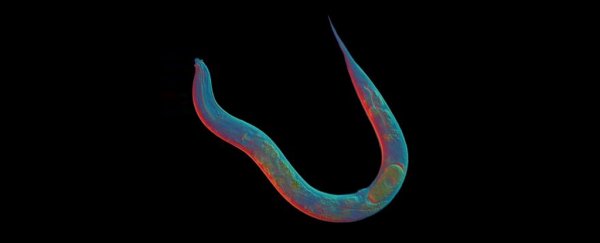Diploscapter pachys has a lineage that goes back about 18 million, and in all that time it seems the tiny little roundworm hasn't cared much for doing the horizontal Hokey-Pokey.
That's quite a record, and now researchers think they know why D. pachys is such an all-star of sexual abstinence; it has amassed a rather unique mix of genes.
Researchers from New York University sequenced the microscopic roundworm's genome and reproductive biology in order to better understand how a species could be so successful for so long without using sex to juggle around its DNA.
When it comes down to it, sex is a bit of a bother. Most of us probably wouldn't go to the trouble if we didn't have natural urges driving us on. The payoff for a species, however, is pretty big.
The reward for spending all that energy finding a mate and convincing them to combine chromosomes is a diversity of individuals appearing and spreading through the population.
In a chaotic, unpredictable environment where climates change, predators come and go, and new diseases are just a germ away, a population has a better chance of surviving another generation if everybody is a little different.
Going the asexual route saves the costs of finding mates and producing copious sex cells, but cloning comes with the risks of having identical members of a population and limited insurance against broken genes.
Some species that are capable of cloning will still indulge in the occasional tryst, coming up with clever ways to strike a balance between making carbon copies of themselves while still gambling on gaining adaptable genes.
For completely asexual species, the gamble doesn't always pay off in the long term, leaving scientists to wonder why it happens at all.
With an impressive 18 million year dry spell, D. pachys is one of the rare species that has clearly made it work.
"This phenomenon is a significant one in understanding evolutionary genetics because it runs counter to the widely accepted view that sexual reproduction is required to eliminate deleterious mutations and for adaptation to a changing environment," says researcher David Fitch from New York University.
It turns out the roundworm has shoved a few tricks up its sleeve to cope with the shortfalls of its reproductive strategy.
Like many other asexual organisms, D. pachys has changed how it makes its sex cells – the sperm and ova.
The process by which sex cells form, called meiosis, usually involves a step that reshuffles a selection of genes between pairs of chromosomes.
This genetic recombination step is missing in the asexual roundworm, meaning the offspring were near perfect copies of their parents.
"Basically, the animals were cloning themselves," says Fitch.
In evolutionary terms, this made it seem like the worm was putting all of its eggs in one basket. That had to be one spectacularly robust container.
Even weirder still, the worm only had a single pair of chromosomes in the first place, where its closest relatives have something like 5 to 7 pairs.
Having just one chromosome (plus a back-up) is ridiculously rare in the animal kingdom; a single species of ant (Myrmecia pilosula) and a parasitic roundworm (Parascaris univalens) are the only other members of this exclusive group.
The secret to this unusual arrangement could be found in how D. pachys structured its chromosome.
Rather than simply losing the other chromosomes during its evolution, D. pachys simply fused together its genome into a single representative chain.
The result is a solid basket for its eggs – having achieved genetic diversity among its genes, it's shoved them into one chromosome which it then maintains by preventing it from reshuffling.
"If there were [reshuffling], the differences between the gene copies might be lost," says Fitch.
"In fact, D. pachys has gotten rid of several of the genes required to make the recombination machinery that exists in sexual organisms."
The moral of the story? If you're on a good thing, stick with it. Even if it means giving up sex for a few million years.
This research was published in Current Biology.
